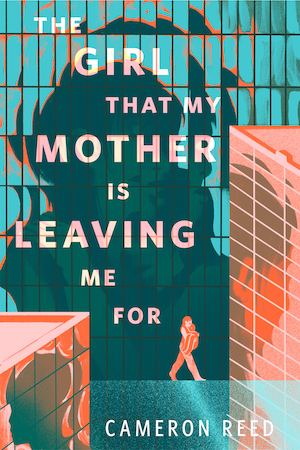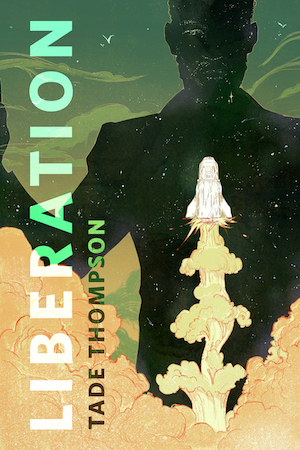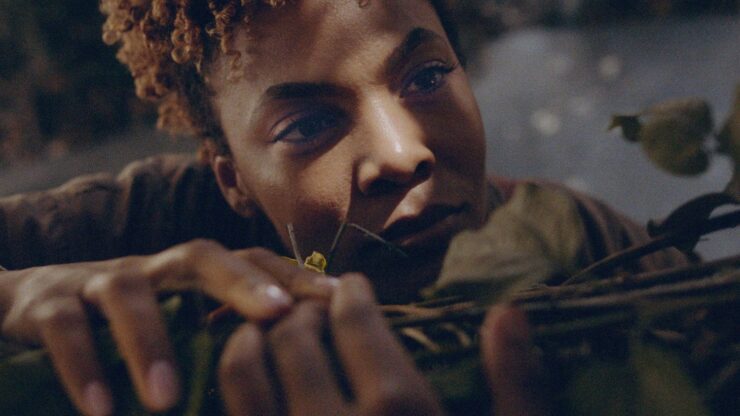Caribbean mermaids are the latest thing. I’ll be reading a written version or two, but this week I’m in the mood for another film. And here’s Lisbon Okafor’s luminous, somewhat mysterious amalgamation of California and the West Indies, dedicated to two women celebrated as “our mothers.”
It is in part about mothers’ love for their children—whether biological or otherwise. It’s also about home, what the word means and where. And it’s about what humans do to those who are different.
Okafor has said that the inspiration for the film came from his family history. At his mother-in-law’s funeral, he learned that she had cared for a young girl whom the community had shunned because she was different. The word he uses is “peculiarities.” She was not like other children, and she was mistreated because of it; but one woman chose to take her in.
That’s the seed from which his Daisy grew. At first we don’t know what’s different about her. She doesn’t talk much; she seems disconnected from the world around her. She ignores the man who tries to either seduce her or help her—it’s not totally clear which, and he doesn’t seem sure about it, either.
She’s being watched over by Violet, who presents as her sister. Violet is working hard and fast to gather enough money to take Daisy home to the West Indies, where Iris has “got out” and is doing very poorly. What she’s got out of is prison, and gradually we learn that she was sentenced for murder; but her family insists that she’s innocent. Another sister, Orchid, has hired lawyers to free her, and they’ve finally, after ten years, succeeded.
Iris is the sisters’ mother. At first we get the impression she confessed to murder to protect Daisy. That’s what the sinister former Inspector Leonce initially believes.
While Violet looks after Daisy, Orchid has been raising Daisy’s daughter Zara, whom Daisy calls Lily. Zara and Daisy have found ways to meet, though Zara doesn’t know who Daisy really is, or why they’re drawn to each other. Orchid is a successful career woman; Violet has bounced around a number of failed careers, including a singing career—she’s mocked as a “one-hit wonder”—and an on again, off again gig as a consultant for Otis, a photographer who is going blind. When she’s not helping him with his art, she’s sending Daisy to clean his studio after a wild and very messy party.
So far we seem to be in a fairly realistic indie film, with estranged sisters, a family emergency, and a small cast of supporting characters. But there’s a moment when Daisy comes into the studio, when she finds Otis passed out under a table, that hints at what’s to come. Daisy lays her hands on him and then withdraws, and he comes to, just catching sight of her as she leaves.
Daisy has secrets. One is harrowing but all too real: she was raped as a young girl by the parish priest back on the island. Zara is the result of that, as is the priest’s murder and Iris’ imprisonment and eventual release.
The other secret is more properly fantastical. Daisy is a mermaid, whom Iris found on the beach as an infant and raised as her own.
A mermaid has certain gifts. One of those is healing. That’s what Daisy does to Otis, though it takes a while for him to realize she’s restored his sight.
The family drama is not restricted to Iris and her daughters. The sisters fled the island when Iris was imprisoned, with the help of a rich white man, Richard, and “Queen” Meera, who may be his wife, or she may not. Richard’s villainous son Drew joins forces with Leonce to track down Daisy, even as Violet is seeking out Richard and Meera to enlist their help in getting back home before Iris dies. (We can guess that she hopes for: to use Daisy’s gift to restore Iris to health.)
Richard seems to be a kind man, more or less. Violet greets him with affection. He shows some empathy, and at the end grieves openly for a loss.
Meera is more ambiguous. She gives off somewhat of an Ursula vibe; she’s not a nice person, but it becomes clear that she has her reasons. They’re not necessarily nice reasons, but there are reasons for that, too.
Mermaids in Okafor’s world are inextricably connected with the waters of the West Indies. It’s not enough that Berkeley is a seaside town: it’s not the right sea. Daisy can’t live in it. She wants, needs, to go home.
Meera, with wealth and power to do what she pleases, believes she’s found a way to keep Daisy safely in Berkeley. She’s filled a pool on her estate with water from the Caribbean. It doesn’t matter to her that Iris is dying, or that the sisters need to go back to her. Iris has outlived her usefulness. It’s all about Daisy now, and giving her a place to be her mermaid self.
Meera has a secret, too. Meera is also a mermaid. She’s Daisy’s mother, who has fallen in love with the land and chosen to live on it.
Mermaids in this world don’t raise their own daughters. They send the infants to be raised by others, as Iris raised Daisy. Once the daughters are grown, at least in Meera’s case, the mothers claim them. In fact this is what is happening with Daisy and Zara. They’re drawn to each other.
Meera has always been on the fringes of Daisy’s life. Now Meera wants more. She wants Daisy with her, with the pool that will allow her to take her mermaid form. It’s simple, streamlined (indie budget being what is, but it serves the purpose). A plain tail, smooth, one single color. No extra frills or fins.
Buy the Book


Under the Smokestrewn Sky
But Meera has made a huge miscalculation. It’s not just the water that restores the mermaid to herself. It’s where the water is. Outside of its proper place, it will give the mermaid back her tail—but then it destroys her. She dissolves into nothing.
By the end of the film, we’ve learned who really killed the priest, and why. We’ve seen what happens to a mermaid when she violates the boundaries of her, let’s call it magic, though the film doesn’t. And we see what happens when she goes back home, and finds her family, and dives into her own proper sea.
There are echoes of the Andersen fairy tale here and there. Meera seems to have some pain in her feet: in one scene, Violet massages Meera’s feet while they have an intense and sometimes heated conversation. Daisy doesn’t have her mother’s fascination with the land. She wants desperately to go back home. Zara is still developing her personality, but she’s curious about who and what she is, and is just starting to develop her gifts and powers.
And then of course, there’s the price to be paid for removing the mermaids’ waters to an alien landscape. These mermaids don’t even melt into sea-foam. They dissolve altogether.
It’s all about the power of home, and the power of family, and the price of being different. Daisy is ostracized because of it, labeled a spirit child by the people of the island, condmned from the pulpit by the priest who eventually assaults her.
It’s about mothers and daughters, too, very much so. Even a mother who sends her child out to fosterage at birth can be ferociously protective when the need arises. She’s still its mother, and it will always be her child.
Judith Tarr is a lifelong horse person. She supports her habit by writing works of fantasy and science fiction as well as historical novels, many of which have been published as ebooks. She’s written a primer for writers who want to write about horses: Writing Horses: The Fine Art of Getting It Right. She lives near Tucson, Arizona with a herd of Lipizzans, a clowder of cats, and a blue-eyed dog.















A story about benevolent mercenaries rescuing a pet cat? This was almost exactly the serotonin boost I needed. I say “almost” because I identified too strongly with the cat’s humans, and the empathetic terror at the thought of my cat getting left on a station scheduled for destruction stressed me out.
All alone, persons have not returned
Felicia: I am maintaining
Strange noises and smells
Felicia: I am maintaining
Strangers appear and one of them is Wrong
Felicia: This is Too Much. I am Done!
Reminds me of my own cat, and a tsunami evacuation.
Oh, this is delightful. And such a nice change! Tor always has interesting fiction, but I get very tired of stories that always end miserably or horribly or in some dark fashion. This is fun, refreshing, and just tense enough, and I really want to know more about the protagonist.
I love the Graf stories! Tor.com has published 2 others if this is the first one you’ve read.
really enjoyed that, thank you
I’m so glad we get more of Graff. I love the way you write and can’t wait for more in the series, it’s such a captivating universe.
I’m w/ Deb, I absolutely love the Graf tales.
My great-aunt Lillie actually had that kind of memory–my dad and his sister used to test her by writing what they wore and what they had for breakfast on a certain date, and then ask her six months later–she was always right (and they did vary what they wore and what for breakfast as well). I can run video of certain events in my head when I need to, but not like *that*.
Loved it, just like I’ve loved the other stories set in this world. I hope we get a full length novel some day. The Visigoth crew are so well characterised, even from the tiniest snippets we see of them.
@3. Quill
There are at least 3 other Graff stories that Carrie Vaughn has written which were published here (and are available as novelettes in ebook form):
An Easy Job (Graff Book 1)
Sinew and Steel and What They Told (Graff Book 2)
Time: Marked and Mended (Graff Book 3)
I would immediately buy a novel with these heros!
Who doesn’t expect some kind of illegal biohazard or miracle fungus in the lab, of course?
What ‘tissue sample’ is that important? How refreshing is it that it’s a green-cat Cat? And it turns out its caretakers were willing to go to such expense and lengths to rescue it. And Felicia is still not, seemingly, in the end, a bio-hazard.
Even better, the unfolding moments as Ell and Graf discover contours of their new relationship is the kind of writing that stays with me.
Thank you. I echo the sentiment from other readers—would love to see a full length book in this world.
@10 Raymond:
Thank you for providing the titles of the previous Graff stories. This is very helpful!
Another WONDERFUL Graff story, with feels and humor and a tense countdown, maybe my favorite because of the bonus totally-catly cat.
more Graff. less cats.